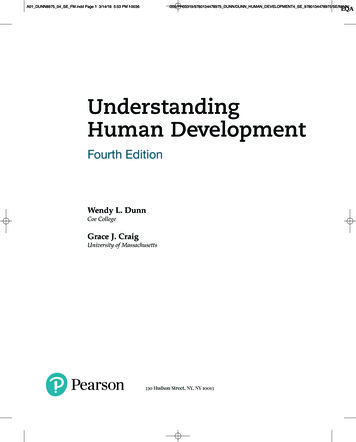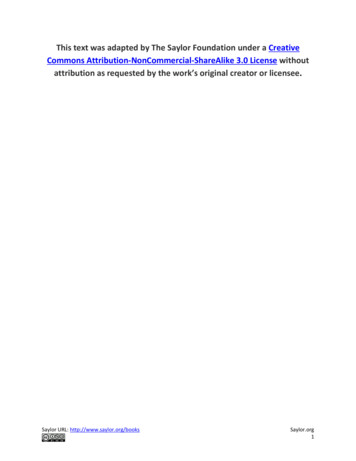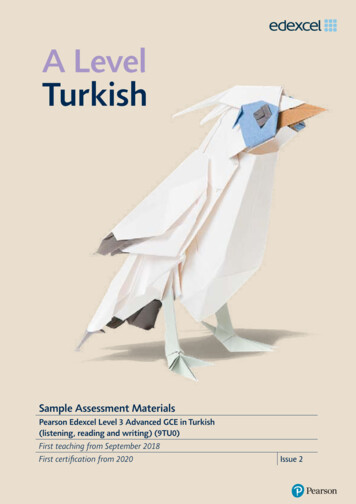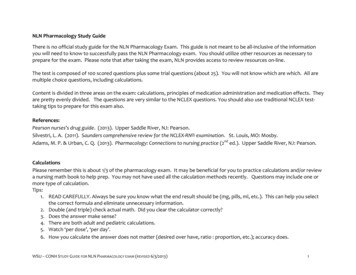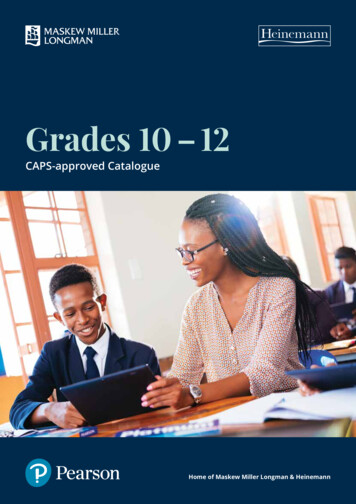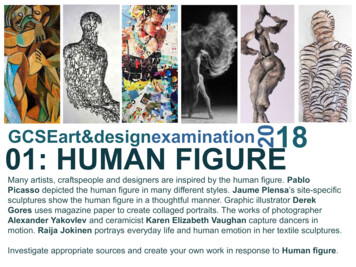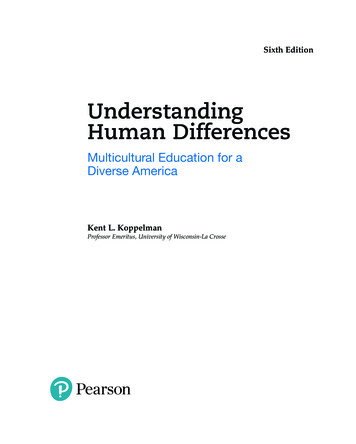
Transcription
Sixth EditionUnderstandingHuman DifferencesMulticultural Education for aDiverse AmericaKent L. KoppelmanProfessor Emeritus, University of Wisconsin-La CrosseA01 KOPP6731 06 SE FM.indd 121/11/2018 12:16
Director and Publisher: Kevin DavisPortfolio Manager: Rebecca Fox-GiegManaging Content Producer: Megan MoffoContent Producer: Faraz Sharique AliPortfolio Management Assistant: Maria Feliberty and Casey CoriellDigital Development Editor: Krista (Slavicek) McMurrayExecutive Product Marketing Manager: Christopher BarryExecutive Field Marketing Manager: Krista ClarkProcurement Specialist: Carol MelvilleCover Design: Pearson CSC, Jerilyn BockorickCover Art: Agsandrew/ShutterstockMedia Producer: Autumn BensonFull Service Vendor: Pearson CSCFull Service Project Management: Pearson CSC, Gowri DuraiswamyEditorial Project Manager: Pearson CSC, Jennylyn RosientoPrinter-Binder: MenashaCover Printer: PhoenixText Font: Palatino LT ProCopyright 2020, 2017, 2014 by Pearson Education, Inc. 221 River Street, Hoboken, NJ 07030. All rightsreserved. No part of this publication may be reproduced, stored in a retrieval system, or transmitted, in anyform or by any means, electronic, mechanical, photocopying, recording, or otherwise, without the prior writtenpermission of the publisher. Printed in the United States.Library of Congress Cataloging-in-Publication DataNames: Koppelman, Kent L., author.Title: Understanding human differences : multicultural education for adiverse America / Kent L. Koppelman, Professor Emeritus, University ofWisconsin, La CrosseDescription: Sixth edition. Boston : Pearson Education, 2018.Identifiers: LCCN 2018041226 ISBN 9780135196731 ISBN 0135196736Subjects: LCSH: Multicultural education—United States. Discrimination—United States.Classification: LCC LB1050 .R477 2019 DDC 370.117—dc23 LCrecord available at https://lccn.loc.gov/2018041226ISBN 10:0-13-519673-6ISBN 13: 978-0-13-519673-1A01 KOPP6731 06 SE FM.indd 221/11/2018 12:16
Dedicated toBurt Altman and Dick Rasmussen,who demonstrated the meaning of the word goodto precede the nouns colleague, mentor, friend,and human being.A01 KOPP6731 06 SE FM.indd 321/11/2018 12:16
A01 KOPP6731 06 SE FM.indd 421/11/2018 12:16
PrefaceWhy Do We Need toUnderstand Diversity?Americans live in the most racially, ethnically, and sociallydiverse country on earth. Yet too often we live, work, andplay as if our own social, gender, or religious group is theonly one that matters. To enjoy the advantages of our nationaldiversity, it is necessary that Americans seek as many factsand consider as many issues as possible to enhance theirability to interact effectively with individuals from diversegroups. This text is not a collection of essays providing multiple perspectives on diversity—there are many books thatalready do that; instead, this text uses research to examineproblems, perceptions, misperceptions, and the potentialbenefits of the diversity that exists in the United States.Understanding diversity is obviously a prerequisite forbecoming an individual who values the diversity in American society.If we are to value and respect the diversity representedby different groups in the United States, we can begin bylearning how to value and respect opinions that differ fromour own. It is not necessary to agree with everything a person might say, but it is necessary that when we disagree,we are able to express disagreement based upon a consideration of all available information and within a context ofmutual respect.The issues this text addresses are not new: Human beings have struggled with them in one form or another forcenturies, as illustrated by the quotations from individualsof different eras that appear in each chapter. The quotationsare not placed randomly in the text, but near a section oftext that relates to each one. For example, near the sectionin Chapter 2 addressing the confusion about positive prejudices and explaining why prejudices are always negative,the quotation by Charles Lamb suggests that prejudicesinvolve “likings and dislikings.” Because Lamb was a respected writer of his era, his confusion about some prejudices being positive was not based on a lack of education orintellectual ability but instead illustrates how ancient thismisperception is.Since the first edition of Understanding Human Differences was published, the rights of various minority groupsin the United States have become common topics for debate. The issue of transgender soldiers being able to serveopenly in the U.S. military has become a controversy affecting the military, the president, and members of Congress.Students used to come to diversity classes oblivious of theissues, but that is less likely now, even though many diversity topics are still misunderstood.New to This EditionTwo specific goals for this edition were (1) to include content that had not been addressed in previous editions, suchas how American Indians are portrayed in K–12 curricula,research on the positive impact of immigrants on urbaneconomies, the consequences for people with a disability oflow wages paid to health care workers, and the reaction tothe proposed travel ban against Muslims, and (2) to expandthe coverage of critical issues such as new developmentsaffecting income inequality, the incarceration of people ofcolor and the school-to-prison pipeline, the ongoing struggle for civil rights for LGBT people, the economic and socialconsequences of closing urban schools, and the principlesand successful practices of restorative justice programs inK–12 schools. Diversity issues are not static as new factors impact ongoing issues and as new issues emerge. It isimportant for all of us to try to be as knowledgeable as wecan to participate in the discussions and debates on theseissues.As with any new edition, care has been taken to updatestatistics and sources and to find more current examplesof issues, and this edition has expanded the number of examples pertaining to issues in K–12 schools. With regardto specific additions of content, the sixth edition of Understanding Human Differences includes the following: Update of racial profiling, especially police officers killing unarmed black men (Ch. 2 and 8) Impact of the 2016 election on student expressions ofprejudice in K-12 schools (Ch. 3) Additional content on increased fears of undocumentedworkers about deportation (Ch. 4) New content on need for K-12 schools to prepare immigrant youth for college (Ch. 4) Added content on Religious Freedom Restoration Actand arguments for teaching about religion in K-12 public schools (Ch. 6) Expanded coverage of economic issues increasinglyaffecting elderly and young Americans (Ch. 9) Expanded coverage of health care issues for lowincome families and for people with a disability(Ch. 9 and 12)vA01 KOPP6731 06 SE FM.indd 521/11/2018 12:16
vi Preface Update on Common Core State Standards and the political opposition (Ch. 13) Updated information on corporate efforts to promotediversity (Ch. 14) New information on gender issues in the military suchas the Marine Corps sexist web site scandal (Ch. 14)e-Text EnhancementsThis text is available as an enhanced Pearson e-Text with thefollowing features: Application Exercises, brand new to this edition, aretied to video and appear in every chapter. Students willbe given a video to watch that ties into chapter concepts and theories, and a few short answer questions torespond to, and then, upon submission of their answers,they will be provided with author-written feedback.Application Exercises allow readers to take their understanding of chapter topics one step further with deeperanalysis. Video Examples are available throughout the sixth edition. About three Video Examples are included in mostchapters. In these videos, students will listen to experts,watch footage of diverse classrooms, listen to teachersand students from diverse classrooms, and watch videosthat challenge biased behaviors and attitudes. Videosare accompanied by reflective questions. Self-Check Quizzes align with learning outcomes andappear as a link at the end of every major section withina chapter in the e-text edition. Using multiple choicequestions, the quizzes allow readers to test their knowledge of the concepts, research, strategies, and practicesdiscussed in each section.A01 KOPP6731 06 SE FM.indd 6Understanding human differences is an ongoing challenge.Initially, scholars focused on individual attitudes and behaviors; later, they described the influence of cultural expectationsin shaping individual attitudes. Finally, scholars addressedinstitutional policies and practices in which either discrimination was intentional against minority groups or it was anunintentional outcome. Vega (1978) describes a conceptualframework incorporating these three elements to understandhuman differences and the oppression of minority groups bydominant groups. This conceptual framework provides thebasis for the organization of this text as we examine individual attitudes and actions, the evolution of cultural biases,and the establishment of discriminatory institutional practices (see Figure F.1).To understand human differences, Vega’s conceptualframework allows us to analyze American cultural, individual, and institutional behaviors. In exploring culture,the objective is to describe cultural norms and standards.What images are associated with the ideal? Any cultureFigure F.1 A Conceptual Framework for the Study ofIntergroup ctionStudents should benefit from exploring all of these issues because each is relevant to today’s society as well asthe future society that they may influence. The first step inproblem solving is to understand why a problem exists andhow it is perpetuated; with that understanding, a person ora community, a state or a nation can implement solutionsto address root causes of persistent problems. Consistentwith this text’s first five editions, the additional content offers information to enable students to understand problemsor issues in society in order to find solutions, or in someOrganization/TheConceptual Frameworkfor this Textnalityctiose Added content on implications for people with a disability of low-wages paid to home care workers (Ch. 12)Inter Examination of arguments from opponents of same-sexmarriage (Ch. 11)cases to describe solutions that have been proposed orimplemented.These features are only available in the Pearson e-Text,available exclusively from www.pearsonhighered.com/etextbooks or by ordering the Pearson e-Text plus print(ISBN 0135166926) or the Pearson eText Access Code Card(ISBN 0135170699).tyali Expanded information on influence of cultural bodyimages on males (Ch. 10)Institutions21/11/2018 12:16
Prefaceassociates particular images with the ideal woman, theideal man, and the ideal family. For many Americans, thoseimages are primarily White middle-class people living in anuclear family. Norms and standards are powerful determinants of individual expectations and behaviors, represented by the arrow pointing from culture to individual.Once we understand norms and standards, we can begin tounderstand what is meant by cultural biases. In a multicultural society, cultural biases can be detrimental to minoritygroups whose norms or standards do not conform to thoseof the dominant culture.The influence of culture on individuals is powerful, ascan be seen in the analysis of individual beliefs, attitudes, values, opinions, actions, and inactions; sometimes what a personchooses not to do reveals as much as his or her actions. Although individuals are influenced by their cultural normsand standards, the Vega conceptual framework portraysthat arrow as double headed, meaning that when significant numbers of individuals accept cultural norms, expresstheir agreement, and behave in accordance with them, thecultural norms and standards are reinforced. Any analysisof individual behavior must include the influence of prejudice on an individual’s choices.Finally, it is critical to analyze institutional practices,policies, and standard operating procedures that areinfluenced by cultural norms and standards as wellas by individual attitudes and behavior. To the extentthat they reflect cultural norms and standards as wellas individual attitudes and behaviors, institutions alsoreinforce them. To relate institutions to human differences,the analysis must focus on discrimination, identifyingboth ways in which the institution intentionallydiscriminates against certain groups and ways in whichthe institution unintentionally advantages certain groupsand disadvantages others. In the late 1980s, the term“intersectionality” was coined to address the socialreality of overlapping identities based on factors such asrace, gender, sexual orientation and social class and theunique forms of oppression occurring as a consequenceof individuals having multiple social identities. Theterm was intended to expand our understanding of thecomplexity of oppression and the need for anti-oppressiveawareness and activity to go beyond the rigid, establishedcategories (Robertson, 2017). This term is being includedin the Vega conceptual framework for the 6th edition of thistextbook in recognition of its usefulness in understandinghow multiple identities influence oppression. Althoughthe Vega conceptual framework describes the intricaterelationship among the three areas—cultural, individual,and institutional—chapter narratives of necessity dealwith each discretely. Readers are asked to keep in mindthe double-headed arrows signifying that all three areasare interlocked to create the following relationships:A01 KOPP6731 06 SE FM.indd 7vii1. Cultural norms and standards influence and are reinforced by individual attitudes and behaviors and institutional policies and procedures.2. Individual attitudes and behaviors influence and arereinforced by cultural norms and standards and by institutional policies and procedures.3. Institutional policies and procedures influence and arereinforced by cultural norms and standards and individual attitudes and beliefs.The four sections of this text that relate to the conceptual framework are as follows. Section 1 focuses on the individual by exploring personalvalues, interpersonal communication, and the way anindividual develops negative attitudes toward otherpeople based on perceptions of group identity (leadingto bias, stereotypes, prejudice, and negative behaviortoward members of these groups). Section 2 focuses on culture by examining the pattern ofhistorical responses in American society toward immigration and the increased racial and religious diversitythat has always been a consequence of this immigration.The final chapter of this section describes how thosewho are pluralism advocates are engaged in efforts toreject this historical pattern of discrimination, but as thefollowing section illustrates, discrimination remains aproblem in our society. Section 3 describes interrelationships among culture,individuals, and institutions to produce discriminationbased on race, gender, social class, sexual orientation,and disability, with institutional issues being a majorfocus of this section. Section 4 addresses changes that have been implemented to reduce levels of individual prejudice andinstitutional discrimination, focusing on major institutions in our society such as K–12 schools, highereducation, business, the media, and the military; theirpluralistic policies and practices are designed to benefitfrom the diversity that exists in our society. This conceptual framework helps us to appreciate not only thechanges that are occurring but also the ongoing issuesthat illustrate how much further we have to go.Before concluding this explanation of Vega’s conceptual framework, consider this example to illustrate howinterreliant culture is with individual and institutional behaviors. Although many forms of family exist in the UnitedStates, our cultural bias is for the nuclear family (the norm).Influenced by this cultural bias, Americans tend to formnuclear families. Even when people with a cultural tradition of extended families immigrate to the United States,they tend to form nuclear families within a few generations,21/11/2018 12:16
viii Prefacesometimes reversing convention with older adult parentsreceiving care in nursing homes rather than at home.American institutions have encouraged the formationof nuclear families because they are more able to relocatein an age in which mobility of workers is highly desirable.In an analysis of discrimination, problems may emerge forminority subcultures that value extended families if theymaintain that value rather than adjust to the cultural norm.As this example illustrates, Vega’s conceptual frameworkhelps clarify the complexity of intergroup relations by describing the related factors involved in the oppression ofminority groups by a dominant group.Inquiry Approach/Discussion ExercisesChapter narratives in this text are presented in an inquiryformat. After a brief introduction, each chapter consists ofrelated questions with responses based on research from avariety of disciplines and on author expertise. As referencesillustrate, information for this text has been collected fromstudies in a broad array of behavioral sciences, includingeducation, psychology, sociology, anthropology, history,science, and literature. Although sources cited are fromrelatively recent publications, some older sources are alsoincluded either because they are still highly regarded in thefield or simply because an author expressed a conclusionreplicated by other research but not stated with as muchclarity.Discussion ExercisesTo reinforce the inquiry approach, exercises for group discussion are provided at the end of each chapter to examineserious ethical questions. Based on specific issues, activitiesencourage readers to reflect on and discuss aspects of issuesthat involve ethical or moral dilemmas. The exercises are notdesigned to manipulate readers into finding a “politicallycorrect” solution; rather, they enable students to hear thevariety of responses from others and appreciate the complexity of individual, institutional, and cultural issues inAmerica today.The Intent of This TextThe information provided in this text is intended to challenge readers to think and talk about issues that each of usmust consider as citizens in a multicultural society; this textis not necessarily intended to change reader values but tochallenge attitudes based on incomplete or erroneous information (see Chapter 1 for a description of the differenceA01 KOPP6731 06 SE FM.indd 8between values and attitudes). Diversity brings benefits aswell as challenges, but the surest way to enjoy the benefits isto meet the challenges with a firm foundation of knowledgeand insight that is based on research from all behavioral sciences. Once students have read this text, the primary goalwill be realized if they have gained a better understanding ofthe issues addressed. Whether or not that is accompanied bychanges in attitudes is up to each individual; and there is anAttitude Inventory in the Instructor’s Manual that accompanies this text. Your instructor may ask for your cooperationin taking this inventory before, during, or on completion ofthe course.The intent of this text is to clarify our understanding ofhuman differences and the role they play in interpersonaland intergroup relations. The Vega conceptual frameworkallows us to recognize how the interlocking circles of cultural biases, individual attitudes and actions, and institutional policies and practices have produced inequities thatcontinue to polarize and all too often prevent Americansfrom achieving ideals first expressed over two centuriesago when dreamers imagined a radical new concept: a nation where each person would be given the freedom to bewhoever he or she wanted to be.Support Materials forInstructorsThe following resources are available for instructors todownload on www.pearsonhighered.com/educators.Instructors enter the author or title of this text, selectthis particular edition of the text, and then click onthe “resources” tab to log in and download textbooksupplements.Instructor’s Resource Manual andTest Bank (0135170567)The Instructor’s Resource Manual and Test Bank includesa wealth of interesting ideas and activities designed to helpinstructors teach the course. Each chapter contains learningoutcomes and a comprehensive test bank containing multiple choice questions, discussion questions, exercises, andsuggested readings. There is also an Attitude Inventory andinstructions for its potential use.PowerPoint Slides (0135170575)Designed for teachers using the text, the PowerPoint Presentation consists of a series of slides that can be shown as isor used to make handouts. The presentation highlights keyconcepts and major topics for each chapter.21/11/2018 12:16
PrefaceAcknowledgmentsI want to thank Tess Cameron for her assistance in revising Chapter 10 on sexism, and Alison Leonard for assistingwith resources for the e-text. I am also grateful to Robin DiAngelo for her contributions to individual and cultural racism in Chapter 8. I also want to extend a special thanks toA01 KOPP6731 06 SE FM.indd 9ixJan Koppelman for her assistance on numerous aspects ofrevising this text and improving both content and illustrations. I am grateful to my editor, Rebecca Fox-Gieg, for heradvice and assistance. Thanks also to the reviewers for thisedition: E. Jean Swindle, Unversity of Alabama; Kelly Jennings-Towle, University of Central Florida; Mary FrancesMattson, Georgia State University.21/11/2018 12:16
A01 KOPP6731 06 SE FM.indd 1021/11/2018 12:16
Brief ContentsSECTION 1SECTION 3Individual Attitudes andInterpersonal RelationsContemporary Dilemmasfor Intergroup Relations1Understanding Ourselves and Others:Clarifying Values and Language 8Racism: Confronting a Legacyof White Domination in America 2Understanding Prejudice and ItsCauses 229Classism: Misperceptions and MythsAbout Income, Wealth, and Poverty 2033Communication, Conflict, and ConflictResolution 4510Sexism: Where the Personal BecomesPolitical 23811Heterosexism: Challenging theHeterosexual Assumption 12Ableism: Disability Does Not MeanInability 2871SECTION 2Cultural Foundations of Oppression inthe United States4567Immigration and Oppression:The Assault on Cultural andLanguage Diversity 17926267 SECTION 4The Challenge of Diversity toRace and Oppression: The ExperiencesAmerican Institutionsof People of Color in America 9713 Pluralism in Schools: The PromiseReligion and Oppression: The Struggleof Multicultural Education 313for Religious Freedom 13414 Pluralism in Society: Creating UnityRejecting Oppressive Relationships:in a Diverse America 339The Logic of Cultural Pluralism for aDiverse Society 159xiA01 KOPP6731 06 SE FM.indd 1121/11/2018 12:16
A01 KOPP6731 06 SE FM.indd 1221/11/2018 12:16
ContentsPreface vSECTION 1Individual Attitudes andInterpersonal Relations1Understanding Ourselves and Others:Clarifying Values and Language 1The Role of Beliefs and Values in Human Differences 2What is the relationship between values andbehaviors? 2What inconsistencies exist between Americanvalues and American behaviors? 4Are values individually chosen, or are we taught toaccept certain values? 5How does the way values are taught explain theinconsistency between values and behavior? 6Why should anyone be concerned aboutinconsistencies between values and behavior? 6Should parents rather than schools teach values tochildren? 7What problems can interfere with making ethicaldecisions? 8Defining Terms Related to Human Differences 8How do negative attitudes develop? 9How does confirmation bias influence people, andcan it be overcome? 10What are the differences among race, ethnicity, andnationality? 11What are minority groups and why are they calledminority groups? 13How have minority groups been perceived by themajority? 14How have labels been used to define and controlsubordinate groups? 15What is the impact of labels on individuals who arelabeled? 16How are negative bureaucratic terms as harmfulas social derisive terms? 17How has our society responded to social problemsexperienced by minority groups? 18Afterword 19 Summary 19 Terms andDefinitions 20 Discussion Exercises 202Understanding Prejudice and ItsCauses 22Conceptions and Misconceptions of Prejudice 23What are examples of misconceptions about prejudice? 23How widespread is prejudice? 24How are prejudices reflected in American media? 24What examples of prejudice exist in our language? 25How does gender prejudice in our languagepromote sexist attitudes? 26What sexist terms for men could be consideredderisive? 27Aren’t some prejudices positive? 27The Perpetuation of Prejudice How are prejudices perpetuated? 2828DENIAL RATIONALIZATIONS 28 VICTIM-BLAMINGRATIONALIZATIONS 29 AVOIDANCE RATIONALIZATIONS 30Causes and Consequences of Prejudice andDiscrimination 31What are the major causes promoting thedevelopment of prejudice? 31How does frustration cause prejudice? 31What do stereotypes have to do with uncertainty,and how do they cause prejudice? 32How does threat to self-esteem cause prejudice? 34How does competition for status, wealth, andpower cause prejudice? 35What is racial profiling? 36What other forms of discrimination are aconsequence of prejudice? 37Is prejudice the main cause of discrimination insociety? 37How does the interest theory explain discrimination? 38How is discrimination explained by theinstitutionalized discrimination theory? 39What can schools do to reduce prejudice? 40Afterword 41 Summary 42 Terms andDefinitions 42 Discussion Exercises 433Communication, Conflict, andConflict Resolution 45Communication and Conflict What is an appropriate definition of communication? How does assigning meaning lead to conflict? How does nonverbal communication lead to conflict? What are other misconceptions about communication? 4646464749COMMUNICATION IS A NATURAL HUMAN ABILITY 49 COMMUNICATION IS A GOOD THING AND SHOULD BEENCOURAGED 50 COMMUNICATION WILL SOLVE ALL OURPROBLEMS 50 COMMUNICATIONS CAN BREAK DOWN 51 COMMUNICATION COMPETENCE IS EQUAL TO COMMUNICATIONEFFECTIVENESS 51How does effective communication occur? What does this communication model suggest aboutconflict resolution? 5153xiiiA01 KOPP6731 06 SE FM.indd 1321/11/2018 12:16
xiv ContentsHow can attitudes toward people or groups createconflict? 53What are the levels of cultural awareness? 53Values and Skills Needed for Conflict Resolution What are some communication style differencesthat are based on culture? How does gender influence communication styles? How do gender differences in communicationstyles lead to misunderstanding and conflict? What kinds of conflicts occur in K–12 schools? What does “Zero Tolerance” mean, and has it beeneffective in schools? What values and skills are necessary for conflictresolution to be effective? Conflict Resolution and the Role of MoralReasoning Theory 5454565757585960DUALISM 61 MULTIPLICITY 61 RELATIVISM 62 COMMITMENT 62With so much conflict occurring, how can conflicts beresolved? 62Afterword 64 Summary 64 Terms andDefinitions 65 Discussion Exercises 65Cultural Foundations ofOppression in the United StatesImmigration and Oppression: TheAssault on Cultural and LanguageDiversity 67Causes of Xenophobia and Nativism in theUnited States Why were nativists anti-Catholic? Why were nativists opposed to radical immigrants? 697071Nativism, Politics, and Social Change 72How successful were the nativists in their politicalactivities? 72Why did nativists fail to form a major politicalparty? 72What influenced twentieth-century nativistattitudes in America? 73How did racism affect nativist attitudes and actions? 74What groups were affected by the addition of racismto xenophobia? 75The Paradox of Xenophobia and Nativism in a Nation ofImmigrants 76How did the eugenics movement influenceanti-immigrant attitudes? 77How is the english only movement an example ofxenophobic behavior? 78What changes in immigration have occurred since thepassage of the immigration and NationalityAct of 1965? 79A01 KOPP6731 06 SE FM.indd 14Attitudes Toward Cultural and Linguistic Diversity 89Why should immigrants maintain their nativelanguage? 89Why do immigrants tend to lose their nativelanguage? 90What alternative pedagogical strategy haveAmerican educators proposed? 91Have research studies identified effectiveapproaches to ELL instruction? 92Why should educators be advocates for bilingualprograms? 93Afterword 94 Summary 94 Terms andDefinitions 95 Discussion Exercises 955Race and Oppression: The Experiencesof People of Color in America 97Historical Benefits of Native American Cultures andContemporary Issues 98What did Europeans learn from native Americans? 98What did European settlers fail to learn from nativeAmericans? 99SECTION 24What American nativist attitudes and actions areevident today? 79How do immigrants today contribute to theAmerican economy? 84What myths about immigrants do manyAmericans believe? 85FOODS AND MEDICINES 99 HYGIENE 99 GOVERNANCE AND GENDER EQUALITY 100 CHILDCARE 100 ECOLOGY 101What was the main source of conflict betweenEuropeans and Indians? 101Why are Indian treaties still important today? 102Why were native American treaties consistentlyviolated? 102What are other contemporary issues affectingIndigenous people? 103The African American Struggle for Freedom andCivil Rights 106How were the Black indentured servants treateddifferently? 107Why did so many Africans die during the middlepassage? 107How did Africans resist the oppressionof slavery? 107Why did Black people fight on the American sideduring the revolutionary war? 108How did the U.S. constitution address the issueof slavery? 108Who opposed slavery, and what did they do? 108What was the undergroun
Understanding human differences is an ongoing challenge. Initially, scholars focused on individual attitudes and behav-iors; later, they described the influence of cultural expectations in shaping individu




